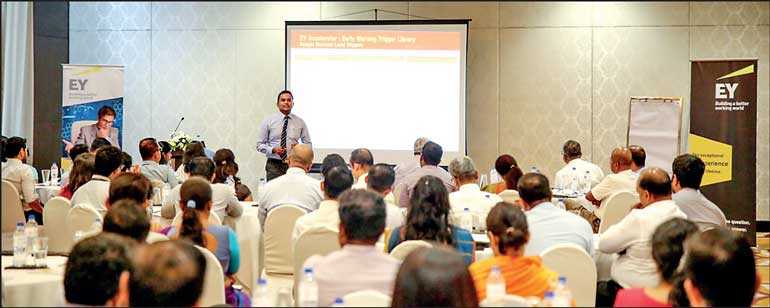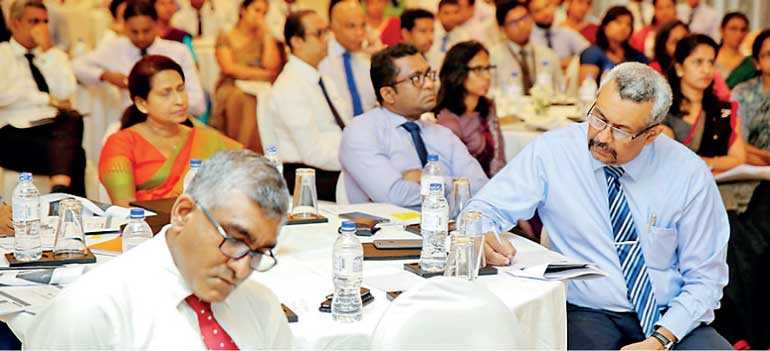Friday Dec 12, 2025
Friday Dec 12, 2025
Friday, 1 November 2019 00:00 - - {{hitsCtrl.values.hits}}



Ernst and Young (EY) Sri Lanka successfully conducted an informative full-day workshop on SLFRS 9 financial instruments and credit risk management, titled ‘Untold Stories of SLFRS 9 and Importance of Credit Risk Management’ at the Mövenpick Hotel, Colombo recently. The packed audience included a large number of chief financial officers, chief risk officers, finance managers, risk officers, credit managers, compliance officers, management consultants, and relationship managers from leading banks in Sri Lanka.
The facilitators of the workshop, EY Sri Lanka and Maldives Head of Assurance and Partner Manil Jayesinghe and Financial Accounting Advisory Services Partner/Principal Rajith Perera, provided an overview of how the banking sector can assess the potential challenges relating to NPAs (Non Performing Advances), from NPA strategy to operations, IT, people and change, as well as the impact of credit risk management on SLFRS 9 financial instruments. The topics covered during the event included post-implementation experiences of SLFRS 9, NPA governance and decision-making, main causes of NPAs and why they are still a problem, importance of credit risk management, importance of rating model validation, and model validation techniques where overview and interpretation of rating model efficiencies were analysed.
Jayesinghe stated, “We have gone through the first cycle of determining provisions under SLRFS 9 and judging by the results of the banks during 2018, all of them have taken hard hits on their income statement. If you look at the current state of the banking sector, some of the key takeaways are, firstly, NPAs were recorded at its highest point in 2018 and continues to remain at roughly the same percentage in 2019. This requires further strengthening of monitoring process. Secondly, as a result of the increase in NPAs during the year 2018 and half year ended 2019, the banks have taken steps to reduce the loan advances granted. Thirdly, due to the increase in risk weighted assets the banks will need to invest in capital optimisation techniques. Therefore, there is a need for the banks to increase their focus towards strengthening their risk management practices and systems such as credit appraisal, underwriting and monitoring processes which will result in increased profitability and strengthening the capital.”
During the latter part of the day, the facilitator paid more attention to techniques and methods that can be used to manage the rising NPA in the banking industry. Popular tools that are being used in our region in managing NPA and the importance of moving to rating-based approaches, and the prerequisites that the banks need to comply with were the salient points discussed.
Rajith Perera stated, “NPA has increased rapidly since 2017, which requires further strengthening of the monitoring process and implementation of an Early Warning Signal (EWS) framework. Theoretically, there should be a negative correlation between GDP and NPA, which could be observed during 2012 to 2018. Since 2017, we can observe an increase in NPA has resulted in an increase in the lifetime expected credit losses.”
During the session, it was reiterated that the banking sector should focus on more proactive measures of credit risk management as opposed to relying on more conventional approaches/techniques. Data was analysed to prove how the banking eco system has changed/evolved over the past years, specifically from the perspective of customer behavior pattern, lending strategies as well as from a profitability perspective. It was also discussed how eroding margins and conventional risk management strategies contribute towards lesser profitability of the bank.
Alternative credit management strategies such as Early Warning Signal (EWS) frameworks would help the financial services sector to deploy more proactive credit management strategy to optimise monitoring of its customers. During his session, Perera also shared post implementation experiences of SLFRS 9 financial instruments which substantially helped the participants to focus on the way forward, such as considering rating-based approaches to determine the expected credit loss provision and how internal rating based approaches could help the banks to record more transparent provisions.
Further, it was demonstrated that banks could perform rating validation from a qualitative and quantitative perspective. Qualitative perspective requires model governance, data quality, model design methodology, model documentation and model usage whereas quantitative perspectives require model level validation to determine the discriminatory power of good and bad customers through statistical techniques such as Gini co-efficiency, Kolmogrov smirnov statistics, area under curve and factor level validation to be performed through information value criteria and Logg-Odds ratio analysis.